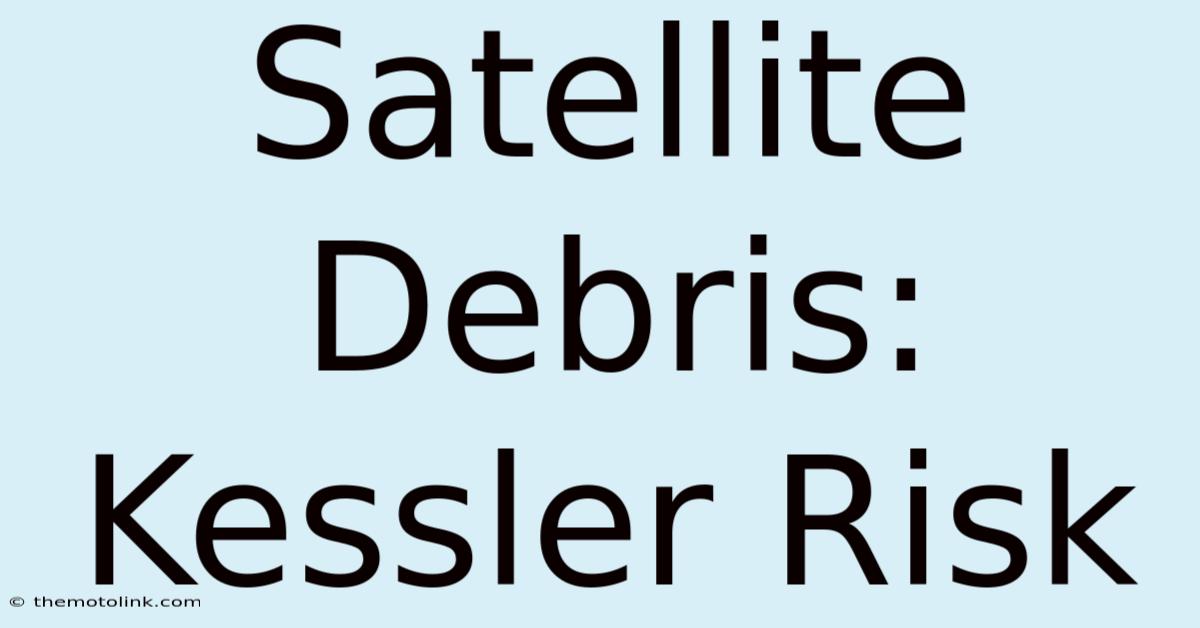Satellite Debris: Kessler Risk

Discover more detailed and exciting information on our website. Click the link below to start your adventure: Visit Best Website nimila.me. Don't miss out!
Table of Contents
Satellite Debris: The Growing Kessler Syndrome Risk
Meta Title: Satellite Debris: Kessler Syndrome Risk & Mitigation Strategies
Meta Description: Learn about the escalating threat of satellite debris and the potential for a catastrophic Kessler Syndrome event. Explore mitigation strategies and the future of space sustainability. #KesslerSyndrome #SpaceDebris #SatelliteSafety
The increasing amount of space debris orbiting Earth poses a significant threat to operational satellites and future space missions. The potential for a cascading collision event, known as the Kessler Syndrome, is a growing concern, jeopardizing our reliance on space-based technologies. This article delves into the complexities of this issue, examining its causes, consequences, and potential solutions.
The Backstory: From Sputnik to Space Junk
The space age, ignited by the launch of Sputnik 1 in 1957, ushered in an era of unprecedented technological advancement. However, this progress has left a legacy: a vast cloud of defunct satellites, rocket stages, and fragments of past collisions, collectively known as space debris. This debris, ranging in size from millimeters to meters, orbits Earth at incredibly high speeds, creating a significant hazard for active satellites. Early warnings about the potential for a catastrophic chain reaction, now known as the Kessler Syndrome, were first raised by NASA scientist Donald Kessler in the 1970s.
Key Insights: Understanding the Kessler Syndrome
The Kessler Syndrome describes a scenario where the density of space debris becomes so high that collisions trigger a chain reaction, creating exponentially more debris. This runaway cascade could render low Earth orbit (LEO) unusable for decades, severely impacting satellite-dependent technologies such as GPS, communication networks, weather forecasting, and Earth observation. The sheer speed of these objects – up to 17,500 mph – means even a tiny piece of debris can cause catastrophic damage to a functioning satellite. [Insert image: Illustration of Kessler Syndrome chain reaction]
Actionable Tips: Mitigation Strategies for Space Debris
Addressing the space debris problem requires a multi-pronged approach involving prevention, remediation, and international cooperation. Key strategies include:
- Improved Design and Operational Practices: Designing satellites for easier de-orbiting at the end of their lifespan. Implementing stricter guidelines for mission planning to minimize the creation of new debris.
- Active Debris Removal: Developing and deploying technologies to capture and remove existing debris from orbit. This includes grappling arms, nets, and laser ablation techniques. [Insert image: Example of a debris removal technology]
- International Collaboration: Establishing and enforcing international space laws and agreements to regulate satellite launches and debris mitigation efforts. This requires global cooperation and a shared responsibility for the long-term sustainability of space.
- Space Situational Awareness: Enhancing tracking and monitoring capabilities to identify and catalog space debris, predicting potential collisions and taking preventative measures. This includes sophisticated radar and optical tracking systems.
Expert Opinions & Trends: The Future of Space Sustainability
Experts across the aerospace industry and academia are increasingly emphasizing the need for proactive measures to prevent a Kessler Syndrome event. The European Space Agency (ESA), for example, is actively involved in developing and testing active debris removal technologies. Private companies are also stepping up, developing innovative solutions for tackling the space debris problem. The growing emphasis on space sustainability highlights the need for a long-term vision that balances technological advancement with environmental responsibility in space. [Insert link to ESA's space debris program]
Future Implications: A Sustainable Future in Space
Failing to address the growing threat of space debris could have profound consequences for humanity's future in space. The potential for a Kessler Syndrome event is a critical concern, not just for scientific research and technological advancement but also for national security and economic stability. Our dependence on space-based technologies is only growing, making the responsible management of space crucial for maintaining essential services and enabling future exploration. [Insert image: infographic depicting the economic impact of a Kessler Syndrome event]
Conclusion:
The space debris problem is a complex challenge that requires urgent attention and international cooperation. The potential for a catastrophic Kessler Syndrome event underscores the need for proactive mitigation strategies, including improved design practices, active debris removal technologies, and stronger international regulations. What proactive steps do you believe are most crucial in preventing a future Kessler Syndrome scenario? Share your thoughts below!
FAQs (with Schema Markup suggestions):
-
Q: What is the Kessler Syndrome? (Schema: FAQPage) A: The Kessler Syndrome is a theoretical scenario where the density of space debris in orbit becomes so high that collisions trigger a chain reaction, creating exponentially more debris and rendering low Earth orbit unusable.
-
Q: How big is the space debris problem? (Schema: FAQPage) A: Tens of thousands of pieces of trackable debris larger than 10 centimeters orbit Earth, along with millions of smaller pieces. This poses a significant risk to operational satellites.
-
Q: What can be done to mitigate space debris? (Schema: FAQPage) A: Mitigation strategies involve improved satellite design, active debris removal technologies, international cooperation, and enhanced space situational awareness.
(Note: Remember to replace bracketed placeholders with actual images, links, and data as appropriate.)

Thank you for visiting our website wich cover about Satellite Debris: Kessler Risk. We hope the information provided has been useful to you. Feel free to contact us if you have any questions or need further assistance. See you next time and dont miss to bookmark.
Featured Posts
-
Syracuse Vs Washington State Holiday Bowl Prediction
Dec 28, 2024
-
Kessler Syndrome Earthbound Future
Dec 28, 2024
-
Matt Reeves Batman Sequel Delayed
Dec 28, 2024
-
Arsenal Life After Bukayo Saka
Dec 28, 2024
-
Maga Cracks Over Foreign Visas
Dec 28, 2024
